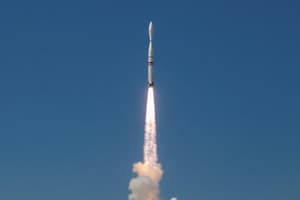Podcast
Questions and Answers
What critical design adaptation allowed Aftershock II to withstand the high-speed atmospheric conditions it encountered?
What critical design adaptation allowed Aftershock II to withstand the high-speed atmospheric conditions it encountered?
- A multi-stage engine that reduced the need for high initial acceleration.
- Titanium-coated fins and specialized heat-resistant paint. (correct)
- A reinforced aluminum alloy frame designed to minimize air friction.
- An active cooling system that circulated liquid nitrogen around the rocket's exterior.
Aftershock II exceeded GoFast's record by reaching a peak speed of $5.5$ times the speed of sound. Although only lasting a short amount of time, why was this an important factor in this project?
Aftershock II exceeded GoFast's record by reaching a peak speed of $5.5$ times the speed of sound. Although only lasting a short amount of time, why was this an important factor in this project?
- Showcased the team's ability to accurately predict flight trajectory.
- Demonstrated the team's expertise in aerodynamics and propulsion systems. (correct)
- Ensured complete combustion of fuel, maximizing efficiency.
- Validated the rocket's structural integrity under immense stress.
Aftershock II's was built by a team of 100 students. What was the most significant benefit to the students who participated in the project?
Aftershock II's was built by a team of 100 students. What was the most significant benefit to the students who participated in the project?
- Practical experience in rocket design, construction, and testing. (correct)
- Gaining access to state-of-the-art facilities and unlimited funding.
- Contributing significantly to theoretical advancements in aerospace engineering.
- Securing guaranteed employment at leading aerospace companies.
Aftershock II's flight can be broken down into phases: launch, ascent, peak altitude, descent What could be the potential impact of Aftershock II's success on future amateur rocketry endeavors?
Aftershock II's flight can be broken down into phases: launch, ascent, peak altitude, descent What could be the potential impact of Aftershock II's success on future amateur rocketry endeavors?
What was the record-breaking significance of Aftershock II's flight regarding altitude, and how did it surpass its predecessor, the GoFast rocket?
What was the record-breaking significance of Aftershock II's flight regarding altitude, and how did it surpass its predecessor, the GoFast rocket?
Flashcards
Aftershock II
Aftershock II
The amateur rocket space altitude record was broken by this rocket built by USC students.
470,000 feet (143.3 km)
470,000 feet (143.3 km)
The height Aftershock II reached, surpassing the previous amateur record.
380,000 feet (115.8 km)
380,000 feet (115.8 km)
The previous amateur rocket altitude record set in 2004.
3,600 mph (5,800 km/h)
3,600 mph (5,800 km/h)
Signup and view all the flashcards
Titanium-coated fins
Titanium-coated fins
Signup and view all the flashcards
Study Notes
- Aftershock II, a rocket built by students at the University of Southern California (USC) Rocket Propulsion Lab (RPL), broke a 20-year-old record on October 20, 2024.
- It launched from Nevada's Black Rock Desert.
- The rocket reached an altitude of 470,000 feet (143.3 km).
- This exceeds the previous amateur rocket altitude record of 380,000 feet (115.8 km) set by the Civilian Space eXploration Team's GoFast rocket in 2004 by 90,000 feet (27.4 km).
- Aftershock II is 14 feet (4 m) in height.
- It broke the sound barrier within two seconds of launch, reaching a maximum speed of 3,600 mph (5,800 km/h), 5.5 times the speed of sound, in just 19 seconds.
- This speed slightly exceeded the speed record set by GoFast in 2004.
- While its engine burned out shortly after launch, Aftershock II continued its ascent, leaving Earth's atmosphere in about 85 seconds after launch and reaching its peak altitude in 92 seconds.
- At its peak altitude, the rocket's nose cone detached and deployed its parachute for a safe landing in the desert, where student scientists retrieved it.
- The success can be attributed to technological innovations developed by the 100-person team at RPL.
- These innovations include titanium-coated fins and heat-resistant paint to endure extreme temperatures at high speeds, as well as student-designed computer systems to track the rocket's position and send back live data throughout the flight.
- RPL was founded in 2005 to launch student-designed and built rockets into space.
- The student-led group first made history in 2019 when their Traveler IV rocket became the first student-built rocket to cross the Kármán line, which marks the internationally recognized edge of space at 328,083 feet (100 km) above Earth's surface.
- RPL's next goals involve developing "sounding" rockets, designed with scientific instruments for space research, because of the permissions needed for launching rockets at higher altitudes.
- The limit for amateur rocketry is 490,000 feet.
- A sounding rocket is a rocket that flies instruments into space for research purposes.
Studying That Suits You
Use AI to generate personalized quizzes and flashcards to suit your learning preferences.





